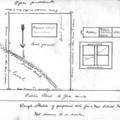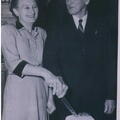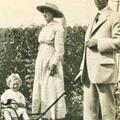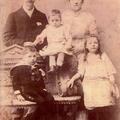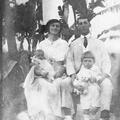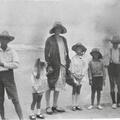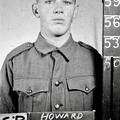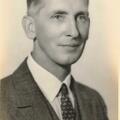< Early Canberra Government Schools
Mundoonan Aboriginal School [1911 - 1916]
Previous Name/s: Edgerton Aboriginal School
Prior Aboriginal schooling at Yass in the 1880s
The 1880 Public Instruction Act made school attendance compulsory for all children from 6 to 14 years of age, and when the Aborigines Protection Board was established in 1883, Aboriginal parents were encouraged to send their children to school.
In April 1883, 16 children from various local Aboriginal camps presented themselves at Yass Public School and were enrolled by the principal, James Brierly. However, a meeting of the non-Aboriginal parents promptly informed him that they objected to the attendance of Aboriginal children, and threatened to withdraw all their own children if the Aboriginal children were not excluded. On the matter being referred to the Minister for Education, George Reid, the principal was instructed to immediately expel the Aboriginal pupils in response to the objections raised regarding their health and cleanliness. An alternative, Reid suggested, was that their education could 'doubtless be provided for at the aboriginal stations at Warangesda and Maloga' (respectively, west of Narrandera and near Moama, by the Murray River).
Accordingly, all the Aboriginal children were expelled. On the initiative of the Reverend Dean O'Keeffe, however, they were accepted into St Augustine Catholic boys' school at Yass, thereby avoiding dislocation to attend remote station schools as proposed by the Minister. A report in the Burrowa News on 21st September gave due praise to Dean O'Keeffe: -
'Eighteen Aboriginal children from the various camps around Yass were collected on Monday morning by Mr Inspector Brennan, who marched them to the school prepared for them at St Augustine's. The youngsters presented a clean and healthy appearance, and appeared highly pleased at the opportunity afforded them of attending school. Dean O'Keeffe deserves great credit for his efforts in endeavouring to do something in the way of educating these poor outcasts; and it is hoped the Aborigines Protection Society will vote some of the funds at its disposal to assist in their education'.
Dean O'Keeffe arranged separate accommodation for them at St Augustine's whilst a special 'Yass Black's schoolroom' was built in the grounds. On 12 October 1883, its foundation stone was officially laid by the Dean at an assembly of over 200 pupils from the two convent schools and St Augustine's. Completed in December, it was described as 'a neat compact brick building on stone foundation'. The Aboriginal pupils, ranging in age from 5 to 14, were visited later that month by Yass police inspector Patrick Brennan, police magistrate Captain Fisher, and Thomas Colls MP, all of whom were favourably impressed with their situation and progress.
State policy on Aboriginal schooling at this time
The Department of Education's experience of parental resistance to the enrolment of Aboriginal children at Yass in 1883 laid the basis of a policy broadly upheld for more than 50 years. Briefly put, it favoured separate education if a sufficient number of Aboriginal children warranted establishing a school especially for them, or otherwise they could attend a normal public school provided 'they are habitually clean, decently clad, and that they conduct themselves with propriety both in and out of school' (Dept of Educ. Memo, 3 Dec. 1884). In practice, this meant that parental complaints about newly enrolled Aboriginal children invariably resulted in their long-term exclusion from school. With respect to Yass, once the Board of Education was informed that Aboriginal children had been accepted into a Catholic school, it was considered pointless to open an Aboriginal school to fulfil state responsibility for their education.
As a result, St Augustine's was for many years the sole provider of Aboriginal schooling in Yass township, though in some small communities away from the town - at Blakney Creek for example, at least some Aboriginal children regularly attended local public schools without discrimination or complaints about their presence.
Aboriginal fringe dwelling at Yass
By the early 1900s between 70 and 100 Aboriginal people, predominantly of mixed-race descent, were living in makeshift dwellings on the northern outskirts of town. Most were settled at the North Yass 'black's camp' - a reserve created for them by Yass aldermen many years earlier. Others were camped, without permission, more comfortably a short distance away beside the Yass River.
To a large extent they lived fairly autonomously under the aegis of the Aborigines Protection Board, visitors from the board and/or the police filing reports on their welfare from time to time. Their living conditions in 1910, for instance, were described in a police report as follows: -
'The camp is at North Yass, 1½ miles from the town. There are 28 half-caste adults and 29 children in it. There are two reserves, of a total area of 4½ acres; both are unfenced. Seven two-roomed huts and two tents are provided. There is no cultivation, the land being unsuitable. Eleven women, 2 old men and a young man (a cripple) and 23 children get rations from the Board. A number of men go rabbiting, and several women do washing and scrubbing in the town.
Several of the aborigines are suffering from tuberculosis. The majority of the aboriginals had been residing on the reserves, and the remainder were on the Yass River, about half a mile distant. There are 18 children of school age, and a few of them attend the convent school, but they are very irregular in their attendance. Six huts are being built on a new reserve at Edgerton, of 1170 acres, and it is intended to remove the camp to that spot'.
(Trove: 'The Western Aboriginals', Evening News (Sydney), 18 June 1910)
The move to Edgerton station in 1910
The 1909 Aborigines Protection Act gave the board new and stronger authority to act in the interest of Aboriginal welfare. Henceforth, station managers were given strict control over anyone entering or leaving a reserve. At Yass in particular, this addressed a concern that the town's Aboriginal reserves were reported to be 'a rendezvous for the lower class of white people', resulting in 'debauchery of the worst kind'. Secondly, the Act gave the board power to remove any Aboriginal people – defined as having 'the appearance of Aboriginality' – from reserves and camping within or near any reserve, town or township. So empowered, the board resolved in 1910 to relocate all Aboriginal inhabitants in close proximity to Yass to its newly purchased station midway between Yass and Murrumbateman - as reported in Sydney's Evening News on 5th March that year: -
'The Board for Protection of Aborigines has for some time past had under consideration the question of removal of the aboriginals' camp from North Yass, as the present location is most unsuitable, and the aboriginals have proved a nuisance to the residents of the town.
Having that in view the board recommended the purchase of a property at Edgerton, some miles out of Yass, which was offered to it at a reasonable figure and is considered to be a very suitable place for the camp....
The erection of six huts at Edgerton, ten miles from Yass (is) to be proceeded with at once. As soon as the huts have been erected, the board purposes having the present reserve at North Yass cancelled, having the existing huts pulled down, and compelling the aborigines to remove to the new reserve'.
The station reserve and its school
Edgerton was modelled on the long-established Aboriginal stations of Warangesda, Maloga and Brungle (near Tumut): that is, a managed, farming community with its own school. Situated off Yass Valley Road, it was not far from the Yass River; a fair-sized property of more than 1200 acres, though the soil was found only moderately suited to cultivation. The main building was the old Edgerton homestead - first built in about 1860, which became the manager's residence.
As was customary on Aboriginal stations, it was expected that the appointed manager would also be the schoolteacher, or if married, his wife. At Edgerton the founding manager-teacher was Herbert Hockey, appointed in January 1911. He stayed on in this position until June 1915, succeeded by J H P Howard. Hockey went to the Macleay River, to take control of a newly established aboriginal station there. Late in Hockey's management, it was reported that the station had six acres of fruit trees, a smaller area of oats sown and harvested, and appeared overall to be well adapted for its purpose: -
'The buildings consist of a large, substantial stone cottage, which is the residence of the manager, and there are also detached buildings comprising a kitchen, general store etc. In the stores are kept everything for the convenience of the residents. There are two rows of small cottages, one of which has been named by the aborigines "Golden Square", the other "Poverty Street". Golden Square is occupied by the first residents on the station, the other by those who came later.
'An orchard has been laid out which contains 600 fruit trees of various kinds, and although the seasons have not been favourable as we would have liked, yet less than a dozen trees have failed to flourish. Various kinds of other work has been carried out by these men, all of which has been satisfactory. In addition to the usual rations, the Aborigines Protection Board has paid the men most liberally for all their labours. At the time of writing many of them are working side by side with white men on the railway duplication works, and receiving the ruling rate of wages, 9/6 per day'.
(Trove: Daily Post (Hobart), 11 January 1915)
As another school was called Edgerton, the station's school was renamed Mundoonan Aboriginal School and formally opened on 21st April 1911. This extract from a 1912 school inspector's report, provides a rare glimpse of Aboriginal classes at Mundoonan – conducted temporarily for the first year in one of the station's old buildings: -
'The school is at present held in a portion of an old kitchen. It has only been established this year. The children are neat in appearance and regular in attendance. A good deal of drawing is done in the early stages. Chats upon natural facts form the nature work and a good deal of knowledge is shown. Civics and morals, simple stories and Scripture stories are told and fairly remembered. Sewing is neat and useful'.
(Trove: Jerilderie Herald & Urana Advertiser , 25 July 1913)
In October 1912, it was gazetted that the Department of Lands had resumed 2 acres of the station's property as the site for a new school and manager-teacher's residence - formerly Edgerton homestead. Yass builders Webster and Newman quoted 125 pounds 17/6 to erect the school, which was accepted. Completed on 13th March 1913, the school buildings consisted of 'a weatherboard building 18 x 16 x 11 feet, galvanised roof, brick chimney, and two weatherboard W.C.s'. A wrangle that ensued with the Aborigines Protection Board about contributing to the building costs, was eventually resolved when the Board advanced 40 pounds to the Department of School Instruction.
Closure of the school and reserve in 1916
After four years as manager-teacher at Edgerton, Herbert Hockey, an 'active Christian Endeavourer', departed in June 1915 to become manager of a newly established Aboriginal station on the Macleay River. J H ('Percy') Howard replaced Hockey at Edgerton, but held the position for only a year before Mundoonan School closed in June 1916. By the end of that year, the station also closed and was sold by the Aboriginal Protection Board.
In 1928 Chief Secretary Albert Bruntnell - addressing concerns from Yass that Aboriginal fringe-dwellers were returning in considerable numbers to their old camps on the outskirts of the town - explained Edgerton's closure as follows: -
'I might point out that several years ago the Board spent over ₤2000 in the establishment of a properly organised station for the Yass aborigines at Edgerton, 10 miles out of the town. Numbers of dwellings were erected, including a school, and a teacher-manager placed in charge. The aborigines refused to remain there and left, the place was closed, and the buildings sold at, of course, a big loss. The Council then allowed these people to form the present camp within the Municipality. I would further point out that the Council has ample powers to prohibit the erection of insanitary buildings, and it also has the power to demolish the camp'.
(Trove: Gundagai Times & Tumut, Adelong & Murrumbidgee District Advertiser, 20/7/1928)
In actual fact, Bruntnell's reasoning about the station's closure was partly incorrect. It wasn't brought about simply because the Aboriginal residents refused to stay, but because it became too costly to maintain as the number of residents shrank - partly due to the nearby railway work winding down, with good wages there coming to an end. As the Aboriginal Protection Board reported when it closed Edgerton on 31 December 1916: over the year the number of residents had averaged 22, of whom 18 were in receipt of rations, but by the end of the year 'there were only 9 half-caste aborigines on the station'
(Trove: NSW Legislative Assembly: Report of Board for the Protection of Aborigines, 1916)
So essentially Edgerton station was founded with good intentions but failed in practice. Aboriginal families returned to their former fringe-dwelling situation: closer to Yass town's services and paid work, and less strictly controlled. It remained to be seen however, whether their children - both from Edgerton and refuges sought elsewhere when the Yass camps were closed - would once again be confined to segregated education.
Additional information on the 'Edgerton Aboriginal Reserve, homestead, school' can be found in an entry of that name to the Yass Valley Heritage Inventory.
(This entry on Mundoonan Aboriginal School was contributed by Keith Amos, former teacher at The Mullion School, out of Yass).
(The biography of 'Percy' Howard was contributed by Patricia Bowes)
Location Map
Related Photos
Teachers
- Hockey, Mr Herbert
01/1911 - 06/1915 - Howard, Mr Joseph Percy Harris
06/1915 - 06/1916
Related Documents
Teacher biographic:
- Joseph Percy Harris Howard (PDF 2.8 Mb)
School Website
NSW Government schools from 1848
- Mundoonan Aboriginal School (external link)
< Early Canberra Government Schools
If you are able to assist our work of identifying, documenting, and celebrating the early bush schools of the Canberra region, please contact us or .



